/Vehicles/Axis/Germany/04-Panzerjaegers/Jagdpanther/File/Jagdpantherhtm | Last Up-date: 05-08-2019
Jagdpanzer V Jagdpanther (Tank Destroyer)
Le 3 août 1942, le comité en charge des Panzers, le Waffenamt, décida que le châssis du Panther serait utilisé pour concevoir un nouveau chasseur de char qui puisse allier l'excellente mobilité et blindage du Panther, au très efficace 88 mm Pak 43 anti-char. Cette arme avait déja été montée sur le Jagdpanzer Tiger(P) Elefant mais ce ne fut guère une réusite, l'engin étant trop lourd, peu mobile et peu fiable. Le Nashorn (Rhinocéros), sur châssis hybride de Pz.Kpfw III/IV, fut également équipé du Pak 43 mais sa superstructure ouverte et légère n'offrait que peu de protection à son équipage, le Nashorn étant cependant plus mobile que l'Elefant qui connu la déroute à Koursk (Russie) en juillet 1943 dès son lancement. En octobre 1942 Daimler-Benz fut chargé du développement du nouveau panzerjäger (chasseur de char) ou jagdpanzer (super chasseur de char) avec l'aide de Krupp. En novembre 1942 une maquette en bois fut réalisée et début 1943 Daimler-Benz débuta la mise au point du prototype jusqu'en mai ou MIAG (Braunschweig) prit le relai en raison du peu d'espace encore disponible sur les plants de montage de Daimler-Benz. Le 20 octobre 1943, un modèle fut présenté à Hitler à Arys, deux prototypes finalisés seront encore produit avant la fin de l'année. Le prototype fut jugé bon pour la production et on lui donna l'appélation de Jagdpanzer V ou Jagdpanther (Sd.Kfz.173).
August 3, 1942, the committee of Panzers, Waffenamt, decided that the chassis of the Panther would be used to conceive a new hunter of tank which can combine the excellent mobility and shielding of the Panther, to very effective 88 mm Pak 43 anti-tank gun. This weapon had already assembled on Jagdpanzer Tiger(P) Elefant but it was hardly a result, too heavy, not very mobile and not very reliable. Nashorn (Rhinoceros), on hybrid chassis of Pz.Kpfw III/IV, was also equipped with Pak 43 but its open and light superstructure offered only little protection to its crew, Nashorn being however more mobile than Elefant which known rout at Koursk (Russia) in July 1943 as of its launching. In October 1942 Daimler-Benz was in charge of the development of the new panzerjäger (tank destroyer) or jagdpanzer (super tank destroyer) with the assistance of Krupp. In November 1942 a model out of wooden was produced and at the beginning of 1943 Daimler-Benz began the development from the prototype until May when MIAG (Braunschweig) took its place because of little space still available on the assembly lines of Daimler-Benz. October 20, 1943, a model was presented to Hitler at Arys, two finalized prototypes will be still produced before the end of the year. The prototype was judged good for the production and one gave it the appelation of Jagdpanzer V or Jagdpanther (Sd.Kfz.173).
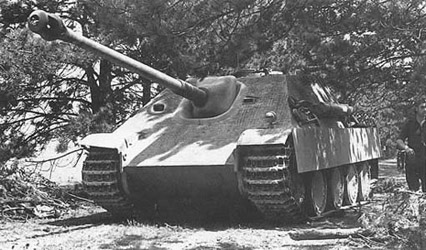 |
Jagdpanzer V Jagdpanther (Frühe Produktion
Modell)
|
src: Site WWII
Vehicles
|
Le Panther Ausf.G fut finalement choisi pour le châssis. On monta sur la caisse supérieur une superstructure recouvrant tout le toit sauf le plateau arrière. La partie frontale de cette superstructure prolongeait simplement le glacis de la caisse. Idem pour les parties latérales. Cette assemblage procurra au nouveau char un large espace de combat bien protégé par un blindage conséquent. Le principale armement de ce nouveau char était le 88 mm Pak 43/3 L/71 (capable de détruire n'importe quel char ennemi à 3000 m) installé dans un masque en groin de cochon ou saukopf. Les premier spécimens avait un fin collier entourant l'ouverture dans le glacis tandis que les plus tardifs possédaient un large collier boulonné et surtout un canon composé d'un tube en deux pièces (pour faciliter le changement des sections endommagées). Le canon du Jagdpanther avait un champ de tir horizontale limité à 13° sur la gauche comme sur la droite et un champ de tir verticale allant de -8° à +14°. Le Jagdpanther pouvait accueillir jusqu'à 57-60 coups de 88 mm. Une MG 34 coxiale montée sur rotule à la droite du canon complétait l'armement ainsi que 4 mitraillettes à l'usage de l'équipage à l'intérieur de la caisse. Pour acquérir un objectif le tireur disposait d'un périscope binoculaire "SflZF5" sur le toit de la superstructure. Pour sa conduite le pilote lui disposait d'un autre périscope dont on voyait les deux fentes (une seule pour les modèles de fin de production) à la gauche du canon sur le glacis. D'autres appareils de vision étaient disposés sur le toit à l'usage du chargeur et du commandant. L'équipage du Jagdpanther était classique et composé du pilote assis à l'avant gauche de la caisse, du radio-mitrailleur assis à l'avant-droit de la caisse, du tireur assis derrière et au dessus du pilote dans la superstructure, du chargeur assis derrière et au dessus du radio-mitrailleur dans la superstructure et du commandant assis dans le coin arrière-gauche de la superstructure. L'accès et la sortie pour l'équipage se faisait généralement par la large trappe montée à l'arrière de la superstructure (servant également au chargement des munitions et à l'évacuation des douilles) même si deux autres trappes étaient présentes sur le toit.
The Panther Ausf.G was finally selected for the chassis. One assembled on upper hull a superstructure covering all the roof except the back deck. The frontal part of this superstructure prolonged simply the glacis. Idem for the side parts. This assembly will provided to the new tank a broad space of combat well protected by a consequent shielding. The main armament of this new tank was the 88 mm Pak 43/3 L/71 (able to destroy any enemy tank from 3000 m) installed in "pig nose" mantlet or saukopf. The first specimens had a fine collar surrounding the opening in the glacis while latest had a broad bolted collar and especially a gun made up of a tube in two parts (to facilitate the change of the domaged sections). The gun of Jagdpanther had a horizontal field of fire limited between 13° on the left and on the right and an elevation from -8° to +14°. Jagdpanther could accomodate up to 57-60 rounds of 88 mm. A coaxial MG34 was mounted on ball mount on the right of the gun supplemented the armament like 4 submachine-guns for the use of the crew inside the hull. To acquire a target the gunner had a binocular periscope "SflZF5" on the roof of the superstructure. For his control the pilot had to him another periscope which one saw the two slits (one slit for the models of end of production) on the left of the gun on the glacis. Others elements of vision were laid out on the roof for the use of the loader and the commander. The crew of Jagdpanther was traditional and was composed of the driver sitting on the left-front of the hull, the radio-machine gunner sitting on the right-front of the hull, the gunner sitting behind and to the top of the pilot in the superstructure, the loader sitting behind and to the top of the radio-machine gunner in the superstructure and the commander sitting in the corner back-left of the superstructure. The access and the output for the crew were generally made by the broad hatch mounted to the back of the superstructure (being used also with the loading of the ammunition and the evacuation of the casings) even if two other hatches were present on the roof.
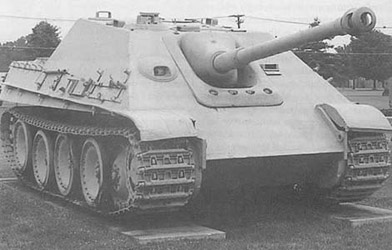 |
Jagdpanzer V Jagdpanther (Spätes Produktion
Modell)
|
src: Site WWII
Vehicles
|
88
mm Pak 43 L/71 Penetration of a shielding plate (mm) under a plunging angle of 30° |
|||||||
Ammo |
Weight |
Velocity |
100
m |
500 m |
1000
m |
1500 m |
2000
m |
| PzGr 39-1 | 10.2 kg |
1000 m/s |
203 |
185 |
165 |
148 |
132 |
PzGr 40-43 |
7.3 kg |
1130 m/s |
237 |
217 |
193 |
171 |
153 |
 |
 |
Superstructure rear hatch |
Saukopf mantlet |
Pz.Kpfw V in action, Armor Number 11 (squadron/signal
publications, inc.)
|
|
La production du Jagdpanther débuta officielement en décembre 1943, mais ne commença réellement que début janvier 1944 sur les plants de montage de MIAG. En novembre 1944 une deuxième unité de production fut implantée chez MNH à Hanovre et par la suite une troisième fut créée chez MBA à Potsdam. Un objectif de 150 exemplaires par mois fut dans un premier temps spécifié mais ne fut jamais atteint. Le pic de production fut réalisé en janvier 1945 avec seulement 72 chars. Il est donc normal que seulement 392 Jagdpanthers furent construits entre décembre 1943 et mars 1945. Certaines sources mentionnent que la production se poursuivit jusqu'à la fin de la guerre et qu'un totale de 425 exemplaires furent produits mais celà n'est pas vérifié.
The production of Jagdpanther began officialy in December 1943, but really did not start that at the beginning of January 1944 on the assembly lines of MIAG. In November 1944 a second production unit was established at MNH in Hanover and thereafter a third was created at MBA at Potsdam. An objective of 150 specimens per month was initially specified but was never reached. The peak of production was carried out in January 1945 with only 72 tanks. It is thus normal that only 392 Jagdpanthers were built between December 1943 and March 1945. Certain sources mention that the production continued until the end of the war and that total of 425 specimens were produced but it is not checked.
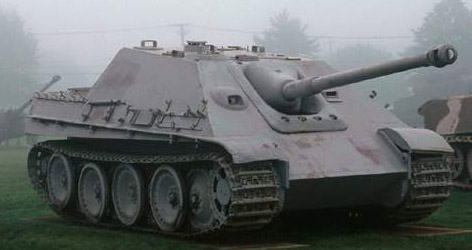 |
Jagdpanther (Aberdeen
Museum) |
|
|
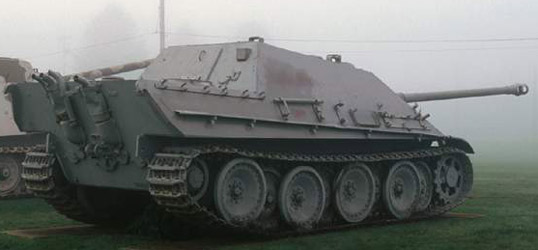 |
Jagdpanther (Aberdeen
Museum) |
|
|
| Production | ||
| December 1943 |
1 |
|
| January-December 1944 |
226 |
|
| anuary-March(May?) 1945 |
165+(33?) |
|
| TOTAL | 392(425?) | |
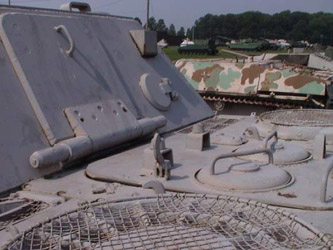 |
Jagdpanther (Aberdeen
Museum) |
|
|
 |
 |
Le Jagdpanther fut le meilleur chasseur de char
allemand de la 2e GM. |
Soldat américain inspectand un Jagdpanther
abandonné. |
| Jagdpanther was the best German tank destroyer of the WW2. |
American solidier examining
an abandonned Jagdpanther. |
src: Site WWII
Vehicles |
src: Site Lexikon
der Wehrmacht |
Les Jagdpanthers furent versés dans des bataillons lourds indépendents anti-char, les schwere Panzerjäger Abteilungens qui se composaient en principe comme suit: 3 compagnies de 14 Jagdpanthers + 3 Jagdpanthers rattachés au QG. Les premiers Jagdpanthers seront versés dans deux bataillons, le 559 et le 654 qui batailleront sur le front occidental. Seul le 654 avait son effectif complet alors que les 559 ne disposera que de 10 à 14 exemplaires en tout. De nombreux Jagdpanthers furent envoyés à l'est mais la plus importante utilisation du Jagdpanther fut la'offensive des Ardennes en décembre 1944 où 51 exemplaires répartis dans 6 bataillons furent utilisés au combat. Les Jagdpanthers furent peu utilisé par les SS, et seulement au sein des 2e SS-Pz.Divisions "Das Reich", 9e SS-Pz.Divisions "Hohenstaufent" et 10e SS-Pz.Divisions "Frundsberg" à raison de une compagnie de 14 exemplaires par division, 42 Jagdpanthers en tout. Ils seront surtout utilisés pour circonsir le soulèvement de Budapest en janvier 1945. Quelques uns participèrent (?) à la défense de Vienne. Les derniers Jagdpanthers produits seront versés en tant que char de remplacement dans les Pz.Abteilungens de la 7e Pz.Division, dans le Régiment de Grenadiers du Führer et dans une brigade blindée spéciale. Le Jagdpanther fut sans conteste le meilleur chasseur de char de la seconde guerre mondiale. Possédant les excellentes capacités motrices de Panther, un excellent blindage et surtout le très performant canon de 88mm, il avait tout pour constituer un arme redoutablement efficace. Un petit nombre seulement fut construit, 382, qui ne put rencontrer les exigences des unités sur le front.
Jagdpanthers were versed in independent heavy anti-tank battalions , the schwere Panzerjäger Abteilungens which were composed in theory as follows: 3 companies of 14 Jagdpanthers + 3 Jagdpanthers attached to the HQ. First Jagdpanthers will be versed in two battalions, the 559 and the 654 which will battle on the Western front. Only the 654 had its complete strenght whereas the 559 does not have that 10 to 14 specimens in all. Many Jagdpanthers were sent to the east but the most significant use of Jagdpanther was during the offensive of the Ardennes in December 1944 when 51 specimens distributed in 6 battalions were used in the combat. Jagdpanthers were used little by the SS, and only within 2nd SS-Pz.Divisions " Das Reich ", 9th SS-Pz.Divisions " Hohenstaufent " and 10th SS-Pz.Divisions " Frundsberg " at a rate of a company of 14 specimens per division, 42 Jagdpanthers in all. They will be especially used to counter the revolt of Budapest in January 1945. Some took part (?) in the defense of Vienna. The produced Jagdpanthers last will be versed as a tank of replacement in Pz.Abteilungens of 7th Pz.Division, the Grenadier Regiment of Führer and in a special armoured brigade. Jagdpanther was without question the best tank destroyer of the second world war. Having the excellent mobility capacities of Panther, an excellent shielding and especially the very powerful gun of 88mm, it had very to constitute a terribly effective weapon. A small number only was built, 382, which could not meet the requirements of the units on the front.
 |
 |
src: Site "Juggernauts
of the second world war" |
src: Site Panzer
Page von Reitsch |
Notons qu'en 1944-1945, Krupp travailla sur une version spéciale du Jagdpanther dont la superstructure était montée à l'arrière comme celle du Jagdpanzer Tiger(P) Elefant et armée dans un premier temps du 88 mm Pak 43/1 et dans un deuxième temps du 128 mm Pak 80 L/55. Cette conversion baptisée Jagdpanther II ne vis cependant jamais le jour. Comme le Panther certains Jagdpanthers furent équipés du système de vision-nocturne (infra-rouge) pour les combats de nuit.
Note that in 1944-1945, Krupp worked on a special version of Jagdpanther whose superstructure was assembled to the back like that of Jagdpanzer Tiger(P) Elefant and army initially of the 88 mm Pak 43/1 and in the second time of the 128 mm Pak 80 L/55. This conversion baptized Jagdpanther II however never realized. As the Panther certain Jagdpanther were equipped with the night-vision system (infra-red) for the combat of night.
 |
 |
| Jagdpanther abandonné sur le front ouest. | Jagdpanther déchenillé et abandonné dans la ville de Rochefort durant la bataille des Ardennes. |
Jagdpanther abandonned
on the Western front. |
Jagdpanther disabled and abandoned in the city of Rochefort during the battle of the Ardennes |
src: Site Lexikon
der Wehrmacht |
Les ingénieurs allemands ont projeté de construire un Jagdpanther II armé avec le canon de 128mm, basé sur Panther II mais son développement n'a jamais atteint le stade du prototype. En effet, le seul prototype de Panther II construit (la caisse seulement) a été capturé par l'armée américaine et fut transporté aux Aberdeen U.S Army Proving Grounds (Maryland) pour des tests. Contrairement au Jagdpanther le canon est ici installé dans une casemate blindée placée à l'arrière (avec une trappe d'accès à l'arrière), le bloc moteur étant dès lors placé au centre entre le poste de pilotage et celui de combat.
German designers planned to build Jagdpanther II armed with 128mm gun based on Panther II but its design never reached prototype stage. Indeed, the only one Panther II prototype built (the hull) was captured by American Army and was transported to Aberdeen U.S Army Proving Grounds (Maryland) for tests. Unlike the Jagdpanther the gun is installed here in a full-armored casemate placed at the rear (with an access hatch at the rear), the engine block is therefore placed in the center between the driver's station and the combat station.
 |
| Jagdpanther II |
src: Site Small
Tracks |
Data |
Drawings |
Sources:
- Pz.Kpfw V in action, Armor Number 11 (squadron/signal publications, inc.)
- Connaissance de l'Histoire (Hachette) - N°17 - " Les chars de combat allemands 39-45"
- Connaissance de l'Histoire (Hachette) - N°5 - " Véhicules blindés allemands 39-45"
- Les Blindés de la Seconde Guerre Mondiale (Atlas)
- Panther Medium Tank 1942-1945 (Osprey Military) - New Vanguard N°67
- Panther Variants 1942-1945 (Osprey Military) - New Vanguard N°22
- Sturmartillerie & Panzerjäger 1939-1945 (Osprey Military) - New Vanguard N°34
- Site "Achtung Panzer" - http://www.achtungpanzer.com
- Site "WWII Vehicles" - http://www.wwiivehicles.com/germany/tank-hunters/jagdpanther.asp
- Site "Second World War Armour" - http://www.onwar.com/tanks/index.htm

/USA/Models/Dioramas/Norman-Bocage/Bt-off.jpg)
/Bt-off.jpg)
